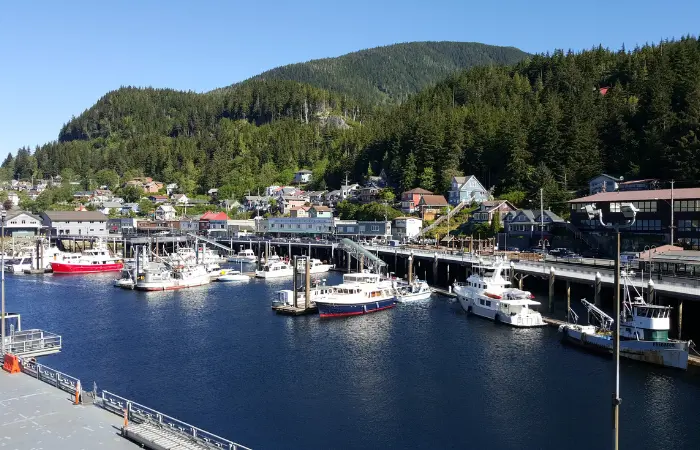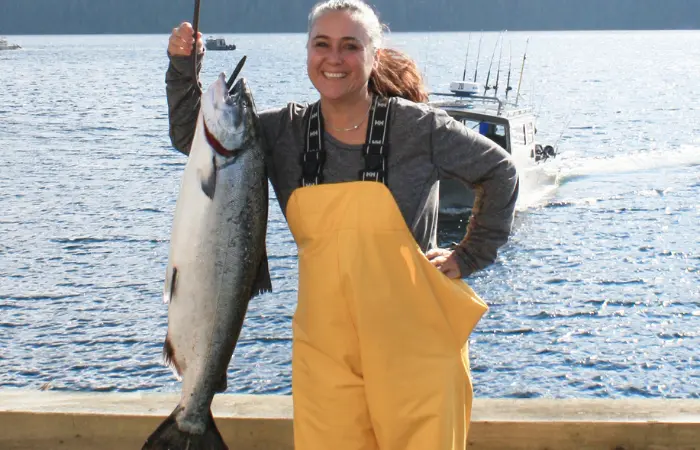
A scenic cove, a stretch of uncharted water, an unfamiliar port — all part of the allure of the aquatic life. Every day offers a new perspective and a new challenge. And at the end of the day, a chance to reflect and relax.

Itching to do a little exploring? Consider this: It’s 900 NM from San Diego to Cabo, and many experienced boaters make that trip fairly often. But what about going the other direction: north from Seattle via the Inside Passage to Alaska? After all, Ketchikan is just 660 NM from Seattle, and Juneau is only another 330 NM.
Apart from generally smooth sailing and scenery that takes your breath away, you’ll experience some of the last true wilderness in the United States and Canada — glaciers, tall-growth forests, fjords, rushing rivers, snow-capped peaks, salmon as long as your arm, bears, seals, bald eagles and moose. The great outdoors, wild and unbound.
The Inside Passage is also the jumping off point to world-class sport fishing retreats like Waterfall Resort Alaska or Steamboat Bay Fishing Club, both just a short hop from Ketchikan. In addition to an unforgettable trip of reeling in boatloads of salmon, cod, halibut and other local species, you’ll take home anywhere from 50 to 100 lbs. of freshly filleted flash-frozen fish.
Another bonus to traversing the Inside Passage is that you experience a wealth of Native culture. Visitors witness performances of traditional music and dance, as well as ancient and modern Native art. Popular items produced by indigenous craftspeople include carvings, baskets, dolls, drums, masks, prints, and etchings, and Native festivals happen in villages year-round.
Sound amazing? An Alaska trip is easier than you think, and a little harder than you might expect. But only a little. Easier because the Inside Passage is tailor-made for cruising. Think of it as the Northwest’s version of the Intracoastal Waterway. Harder because of the occasional unpredictability of nature in these parts. You might have to navigate a sudden squall, a stretch of fluky open water, a whipping wind or wild temperature swings — or maybe all four. But that’s what we love about exploring. And if you properly plan and prepare, you’ll have the trip of a lifetime.
Consider a few things when charting an Inside Passage itinerary.

June through August are the peak months to head north, although May to September is also considered in-season. Allow about a month for the Seattle-Ketchikan-Seattle round-trip to do it right; a bit longer if you’re going as far as Juneau or Skagway.
A recent post on CruisersForum with a 37-foot Nordic Tug says this about the Inside Passage: “We go May through September...typically traveling some 4,000 NM. It sure can be cool and rainy some days, but it’s hard to beat for scenery, critters, and fishing/ crabbing/shrimping. It can be 80 degrees too, but not very often. Typical temps range from 50-65. Have good rainwear.”
Although a stop in Vancouver is tempting, as it’s only about 100 NM north of Seattle. Save it for the return trip. Moving north through the Strait of Georgia, Vancouver Island is on your port side. It’s the largest and most populous island along the west coast of the Americas at nearly 300 miles long. Dozens of parks and nature preserves dot the eastern shore.
In Comox visit the Comox Air Force Museum on the site of a WWII-era Air Force base. A string of marinas from Campbell River (opposite the Discovery Islands; worth checking out) to Port Hardy offer a full array of services and amenities.
Just north of Calvert and Hecate Islands is the Hakai Lúxvbálís Conservancy Area, British Columbia’s largest marine park, offering scenic coastline with heavily forested hills, 3,000-foot peaks, lagoons, sandy beaches and spits, coves and channels, all ideal for fishing, scuba diving, kayaking and hiking.
Home to the Heiltsuk First Nation, Bella Bella is located on Campbell Island, about 100 NM north of Port Hardy. It has a bank, large general store, police station and the only hospital and pharmacy on the Central Coast. Head around to the east side of Denny Island and up the Dean Channel to Eucott Bay Hot Springs near Ocean Falls. Among the largest on the coast, these hot springs are popular with boaters, as Eucott Bay offers good anchorage and shelter for small craft.

Just north of Bella Bella lies Fiordland Conservancy, a 350,000-square-mile preserve that’s home to glacial fjords, waterfalls, inlets, bays and islands. The scenery is breathtaking. Boaters and kayakers see bears, wolves and deer along the craggy shoreline.
Unfortunately, landing sites are scarce due to the area’s topography, with crashing estuaries hugging the base of steep ice-capped mountains in many places. Mussel Inlet and Kynoch Inlet are large enough to provide scenic shelter. The nearest road- accessible community, Bella Coola, is about 60 miles southeast, and supplies are available at the Kitasoo Band Store in the village of Klemtu on Swindle Island, where the Spirit Bear Lodge provides “refined waterfront accommodations.”
Prince Rupert (pop. 12,000) is located on Karen Island, just north of the mouth of the Skeena River. The city sits along the island’s northwestern shore, fronting on Prince Rupert Harbour. The port is the deepest ice-free natural harbor in North America and the third-deepest natural harbor in the world. Cow Bay Marina offers 51 slips for boats up to 100 feet, as well as power service, fresh water, showers, laundry facilities and Wi-Fi. Waterfront shops and cafes are near the marina, and Prince Rupert boasts inns, guesthouses, hotels, bars, restaurants, supermarkets and a public library.
The Museum of Northern British Columbia showcases the region’s natural and cultural heritage, while the North Pacific Cannery traces the city’s salmon-canning history. Other attractions include the First Nations Carving Shed, Kwinitsa Station Railway Museum, Totem Park and Sunken Gardens.
From Prince Rupert, you must navigate one more stretch of exposed water at Dixon Entrance before heading up and into Ketchikan, which occupies about four square miles of land hugging the western edge of Revillagigedo Island. Expect no big chain hotels or fast-food franchises, but lots of jewelry stores, souvenir shops (catering to the cruise ship crowd), and bars and restaurants.
Head over to Creek Street and ride the funicular up the hillside to Cape Fox Lodge to get a true overview of the place. Like most Alaska cities, Ketchikan retains a frontier vibe. It’s a fascinating mix of people passing through on their way to somewhere else with blue-collar residents who entertain them, outfit them and get them where they’re going: shopkeepers, service workers, tour operators, pilots, etc.
Misty Fjords National Monument is just east of Ketchikan, and the 100-mile-long Behm Canal cuts through the middle of it, separating Revillagigedo Island from the mainland and offering spectacular scenery in Rudyerd Bay, Punchbowl Cove and Walker Cove. “Dramatic waterfalls plunge into the saltwater through narrow clefts, or course over great rounded granite shoulders, fed by lakes, streams and 150+ inches of annual rainfall,” notes The Travel Alaska website.

Wrangell is about 150 miles south of Juneau on the northern tip of Wrangell Island. Founded by Russians in the early 1800s, it’s one of the oldest non-Native settlements in Alaska. The oldest Catholic church in Alaska, St. Rose of Lima, was established at Wrangell in 1879. A top destination for birdwatchers, it’s home to the largest concentration of bald eagles on the Inside Passage.
Petersburg was incorporated in 1910, attracting Scandinavian immigrants and resulting in the town’s nickname, “Little Norway.” The Sons of Norway Hall was built on one of the piers in 1912 and still stands. Every year, the town marks The Little Norway Festival, held on the third weekend in May.
Venturing farther north, Tracy Arm is about 75 miles up the Inside Passage from Petersburg off Holkham Bay, adjacent to Stephens Passage. The 27-mile-long fjord offers a magnificent setting of icebergs and glaciers, and is a favorite cruise ship destination. Wildlife is plentiful, and in summer you spot whales, eagles, seals and bears.
Alaska’s capital, Juneau, has a population of 30,000+, but that figure swells between May and September, with a daily influx of thousands of cruise ship passengers. Interestingly, no roads connect the city to the rest of the state or to North America; all goods coming in or out go by ship and plane.
Despite its relative isolation, Juneau hosts several festivals, including the Alaska Folk Festival in April, Juneau Jazz & Classics Festival in May, and the Alaska Native cultural festival that’s held every other year in June. South Franklin Street, the city’s main thoroughfare, is a bustle of historic sites, shops, bars and restaurants. St. Nicholas Russian Orthodox Church was built in 1894 by newly baptized Orthodox Natives and Siberian gold miners.
Located about 12 miles from downtown Juneau, the Mendenhall Glacier is a popular attraction. Part of the Tongass National Forest, the 5,815-acre Mendenhall Glacier Recreation Area extends from the Juneau Icefield to Mendenhall Lake, with views of glaciers drawing tourists and boaters. The Mendenhall is just one of 38 major glaciers that flow from the Juneau Icefield.
Skagway is at the northernmost point of the Inside Passage at the far end of Lynn Canal. Another favorite cruise ship stop, its historic district of about 100 buildings tells the story of the city’s past as a gold-mining boomtown. Skagway and the nearby valley of Dyea were the starting point for about 40,000 people who headed into the Yukon primarily by way of the Chilkoot Trail during the 1890s Klondike Gold Rush. It’s also home to the popular White Pass and Yukon Route narrow gauge railroad, which operates in the summer when the town entertains thousands of visitors a day.
Marinas and moorings are scattered up and down the Inside Passage, making it relatively easy to rest, restock and refuel. Posts on CruisersForum note that boats with a 200-300 NM range, fuel-wise, will have flexibility to handle any route or weather changes. “I don’t think there’s anywhere much more than 140 NM from a fuel stop,” says one, “[and] many are a lot closer together than that.”

Ahoybc.com website is also a great resource. Click on the “For the Skipper” tab to find weather and chart purchases, tips, and links to info on reporting to Canadian customs, fishing regulations and other pertinent data.
Canada Border Services Agency’s website has a section under its “Plan Your Trip Across the Border” tab entitled “Reporting Requirements for Private Boaters” that provides details.
For preliminary research, the Cruisingnw.com website recommends reading: “The Waggoner Cruising Guide, updated yearly, is an invaluable resource for the Inside Passage as far north as Ketchikan. Other good titles: The Exploring Series by Don Douglass and Réanne Hemingway-Douglass, Dreamspeaker Guides, and Ports and Passes."
Stay up to date with the latest articles, news and all things boating with a FREE subscription to Marinalife Magazine!
